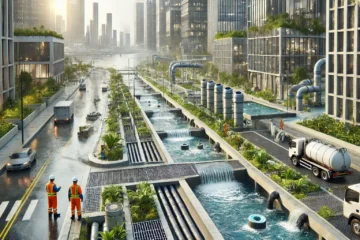Microgrids: Revolutionizing Local Power Systems
A microgrid is a localized power system that can operate independently or in conjunction with the main power grid. It is designed to serve a specific area, such as a campus, industrial facility, or residential neighborhood, providing energy reliability, efficiency, and resilience.
Key Features of Microgrids
- Self-Sufficiency
- Microgrids are capable of generating, distributing, and storing their own electricity.
- They often incorporate renewable energy sources like solar panels and wind turbines.
- Flexibility
- Operate in two modes:
- Grid-connected mode: Works in coordination with the central grid.
- Island mode: Operates independently during grid outages or emergencies.
- Operate in two modes:
- Energy Storage
- Integration of batteries or other energy storage systems allows microgrids to store excess power for later use.
- Smart Control Systems
- Use of IoT and AI for real-time energy management, load balancing, and predictive maintenance.
Advantages of Microgrids
- Energy Reliability
- Protects against power outages by providing a localized energy supply.
- Environmental Benefits
- Encourages the use of clean, renewable energy sources, reducing carbon footprints.
- Cost Efficiency
- Reduces dependency on centralized power, leading to lower transmission and distribution costs.
- Scalability
- Easily expandable to meet growing energy demands.
- Resilience to Disasters
- Acts as a reliable backup in regions prone to natural disasters or grid failures.
Applications of Microgrids
- Industrial Facilities
- Ensures uninterrupted power for critical operations, even during grid failures.
- Hospitals and Data Centers
- Provides reliable and continuous energy to life-saving equipment and critical systems.
- Remote Communities
- Supplies electricity to areas not connected to the main grid.
- Military Bases
- Enhances energy security and operational independence.
- Urban Developments
- Supports smart cities with sustainable and efficient power systems.
Challenges in Implementing Microgrids
- High Initial Costs
- Infrastructure development, renewable energy systems, and advanced controls require significant investment.
- Complex Integration
- Balancing power between microgrids and the central grid can be challenging.
- Regulatory Barriers
- Policies and regulations may not always favor decentralized energy systems.
- Maintenance and Operation
- Requires skilled personnel and advanced monitoring tools to ensure efficient performance.
Future of Microgrids
- Increased Adoption
- With the rising demand for energy independence and sustainability, microgrids are becoming mainstream.
- Technological Advancements
- Integration of AI, blockchain for energy trading, and advanced storage solutions will enhance microgrid performance.
- Hybrid Systems
- Combining multiple renewable energy sources with storage for optimized energy supply.
- Support for Electrification
- Facilitating the transition to electric vehicles and decentralized energy systems in urban and rural areas.
Microgrids represent a paradigm shift in how energy is generated, managed, and distributed. By addressing energy challenges and promoting sustainability, they are set to play a pivotal role in shaping the future of power systems.


